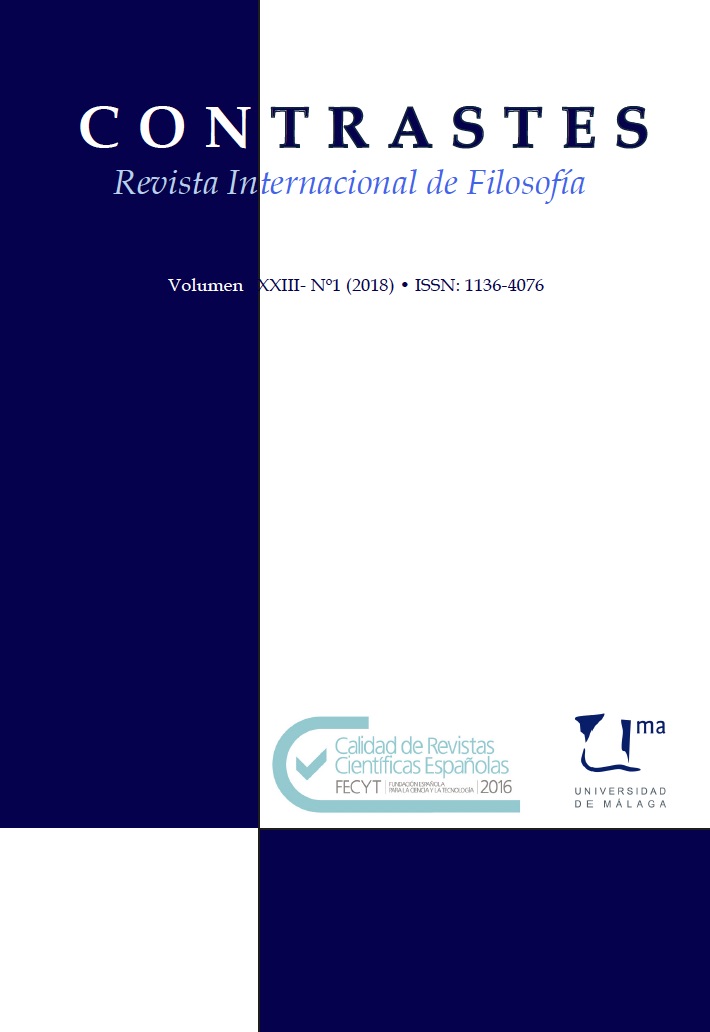Negativity and Aesthetic Reception: Difficult Emotions in Light of Adorno’s Dialectical Thought
DOI:
https://doi.org/10.24310/Contrastescontrastes.v23i1.5466Keywords:
Dialectics, Negativity, Adorno, Negative emotions, Modern aesthesisAbstract
The concept of negativity runs through Adorno’s dialectical thinking in his intention to refute or oppose the establishment, to rescue the victims of any will of dominance from submission and oblivion. This desire for recovery is related here to the rehabilitation of negative emotions in contemporary aesthetic reflection. This is the case of disgust, which despised in modern aesthetic tradition in the name of pleasure, allows us to notice a will of dominance analogous to that denounced by Adorno. Indeed, both emotions, disgust and pleasure, have been recently approached from a similar dialectic position thus conferring dignity to the former.
Downloads
Metrics
Publication Facts
Reviewer profiles N/A
Author statements
Indexed in
-
—
- Academic society
- N/A
- Publisher
- Universidad de Málaga
References
ADORNO, Th. W. 2005 (1966): Dialéctica negativa. La jerga de la autenticidad, tr. A. Brotons Muñoz. Madrid: Akal, Obra Completa 6.
ADORNO, Th. W. 2006 (1951): Mínima moralia: reflexiones desde la vida dañada, tr. J. Chamorro Mielque. Madrid: Akal, Obra Completa 4.
ADORNO, Th. W. 2004 (1970): Teoría estética, tr. J. Navarro Pérez. Madrid: Akal, Obra Completa 7.
ÁLVAREZ LÓPEZ, P. 2000: Espacios de negación. El legado crítico de Adorno y Horkheimer. Madrid: Biblioteca Nueva.
BULLOUGH, E. 1957 (1912): «Aesthetic distance as a factor in art and an aesthetic principle», en Aesthetics. Lectures and essays, ed. Elizabeth M. Wilkinson,
Stanford CA: Stanford University Press –reimpreso-.
BURKE, E. 2010 (1756): De lo sublime y de lo bello, tr. M. Gras Balaguer. Madrid: Alianza.
GALÉ ARGUDO, M. J. 2014: «Democracia y derechos humanos en la filosofía de Theodor W. Adorno», Bajo palabra. Revista de Filosofía, II, 9, pp 37-44 (https://
revistas.uam.es/bajopalabra/article/view/bp2014.9.003/71).
GÓMEZ, V. 1998: El pensamiento estético de Theodor W. Adorno. Madrid: Cátedra.
GUTIÉRREZ POZO, A. 2007: «Utopía en negro. El color negro en la estética negativa de Adorno y el arte radical contemporáneo», en Diego Romero de Solís, Jorge
López Lloret e Inmaculada Murcia Serrano (eds.), Variaciones sobre el color. Sevilla: Secretariado de Publicaciones de la Universidad de Sevilla, 2007, pp.
-208.
HORKHEIMER, M. y ADORNO, Th. W. 2001 (1947): Dialéctica de la Ilustración. Fragmentos filosóficos, tr. J. J. Sánchez. Madrid: Trotta.
INFANTE DEL ROSAL, F. 2017: «Jacques Rancière. Contra-historias estéticas», Daimon. Revista internacional de filosofía, 70, pp. 67-81 (http://dx.doi.
org/10.6018/daimon/224791).
IRIONDO ARANGUREN, M. 2015: «Recordando a Adorno: estrategias narrativas y memoria de la violencia», en Aitor Aurrekoetxea y Fernando Golvano (eds.),
Prismas críticos. Lecturas sobre Theodor W. Adorno. Granada: Comares, pp. 41-61.
KANT, I. 2001 (1790): Crítica del juicio, tr. M. García Morente. Madrid: Espasa- Calpe.
KORSMEYER, C. 2014: «Curiosity and aversion in eighteenth-century British aesthetics», en Jerrold Levinson (ed.): Suffering art gladly. Londres: Palgrave
MacMillan, pp. 45-67.
KORSMEYER, C. 2011: Savoring disgust. The foul and the fair in aesthetics. Oxford/ Nueva York: Oxford University Press.
LEVINSON, J. 2015 (2006): Contemplar el arte. Ensayos de estética, tr. F. Campillo. Madrid: Antonio Machado Libros, pp. 68-71.
MENKE, Ch. 2011: Estética y negatividad, tr. P. Storand y G. Leyva. Buenos Aires: Fondo de Cultura Económica.
MENKE, Ch. 1997 (1991): La soberanía del arte. La experiencia estética según Adorno y Derrida, tr. R. Sánchez Ortiz de Urbina. Madrid: Visor.
RANCIÈRE, J. 2014a (2011): Aisthesis. Escenas del régimen estético del arte, tr. M. Manrique y H. Marturet. Santander, Shangrila.
RANCIÈRE, J. 2104b (2000): El reparto de lo sensible. Estética y política, tr. M. Padró. Buenos Aires, Prometeo.
RANCIÈRE, J. 2005: Sobre políticas estéticas, tr. M. Arranz. Barcelona, Universitat Autònoma de Barcelona.
RETAMAL, Ch. 2016: «La melancolía de izquierda y el utopismo espectral», Pensamiento. Revista de investigación e información filosófica, 72, 271, pp. 371-393 (http://revistas.upcomillas.es/index.php/pensamiento/article/ view/6999/6806).
SILVIA, P. J. 2009: «Looking past pleasure: anger, confusion, disgust, pride, surprise and other unusual aesthetic emotions», Psychology of Aesthetics, Creativity and
the Arts, 3, 1, pp. 48-51.
SMUTS, A. 2014: «Painful art and the limits of well-being», en Levinson Jerrold (ed.), Suffering art gladly. Londres: Palgrave MacMillan, pp. 123-152.
TAFALLA, M. 2003: Theodor W. Adorno. Una filosofía de la memoria. Barcelona: Herder.
VILAR, G. 2015: «La precariedad del arte. Adorno, telos del arte y reconciliación», en Aitor Aurrekoetxea y Fernando Golvano (eds.), Prismas críticos. Lecturas sobre Theodor W. Adorno. Granada: Comares, pp. 1-21.
ZAMORA, J. A. 2004: Th. W. Adorno. Pensar contra la barbarie. Madrid: Trotta.
Downloads
Published
How to Cite
Issue
Section
License
This journal provides immediate free access to its content under the principle of making research freely available to the public. All content published in Contrastes. Revista Internacional de Filosofía, are subject to the Creative Commons Attribution-NonCommercial-ShareAlike 4.0 license whose full text can be found at <http://creativecommons.org/licenses/by-nc-sa/4.0>
It is the responsibility of the authors to obtain the necessary permissions of the images that are subject to copyright.
Authors whose contributions are accepted for publication in this journal will retain the non-exclusive right to use their contributions for academic, research and educational purposes, including self-archiving or repository in open access repositories of any kind.
The electronic edition of this magazine is edited by the Editorial Service of the University of Malaga (Uma Editorial), being necessary to cite the origin in any partial or total reproduction.










5.png)
